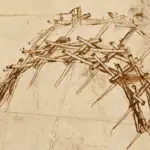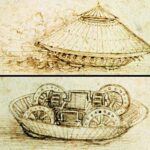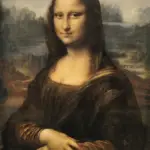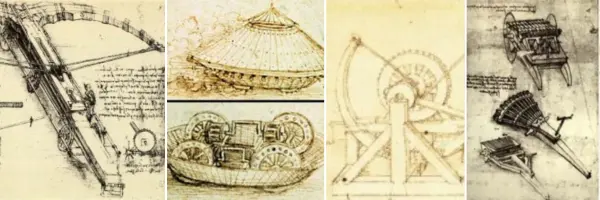
Da Vinci War Machines captivate the imagination with their blend of artistry and engineering. Leonardo da Vinci, known for his genius and creativity, designed several innovative machines that pushed the boundaries of warfare during the Renaissance.
His inventions, such as the armored car and the giant crossbow, demonstrate his understanding of science and battle psychology.
Leonardo’s creations reflect a keen foresight into military technology and tactics.
The armored car is considered a forerunner of the modern tank. It can move in any direction while carrying heavy weaponry. This machine was designed for practical purposes and psychological impact, aiming to intimidate and scatter enemy forces.
His machines reveal the unique intersection between art and technology that characterized da Vinci’s work.
These inventions represent his engineering prowess and ability to anticipate future developments in warfare.
Visit information about Leonardo da Vinci’s role as a military engineer to explore his remarkable contributions further, including his machine gun concept and its potential influence on future weapons.
Leonardo da Vinci: The Inventor
Leonardo da Vinci exhibited an extraordinary talent for designing innovative machines. His work extended beyond painting, as he crafted numerous inventions that showcased his genius.
Among his most notable creations is the Leonardo da Vinci Armored Car, an early tank concept designed for military use.
Da Vinci’s interest in flight led him to design the Da Vinci Flying Machine. Although it never took flight, his sketches displayed a deep understanding of aerodynamics.
This machine featured wings and a structure reminiscent of modern-day gliders.
His military designs included the Leonardo da Vinci Machine Gun Design, the 33-barreled organ—this concept aimed to improve the fire rate of artillery, making it a precursor to rapid-fire weapons.
Leonardo also explored engineering with his Da Vinci Giant Crossbow, a massive weapon that launched large projectiles. This design combined artistry with functionality and was intended to intimidate opponents with its size.
While some of his designs remained concepts, they played a crucial role in the evolution of engineering.
Da Vinci’s imaginative machines, such as his tank, have fascinated historians and engineers alike. They embody the transition between art and science during the Renaissance.
His work demonstrated an exceptional ability to envision machines well before their time.
Leonardo da Vinci remains a central figure in the history of engineering innovation, from his flying machines to his wartime inventions.
Engineering Principles Behind the Machines
Leonardo da Vinci’s war machines combined innovative engineering with forward-thinking design concepts. They demonstrated a deep understanding of motion and materials and integrated mechanical principles that were advanced for their time.
Kinetics and Ballistics
Da Vinci’s war machines showcased advanced principles of kinetics and ballistics.
His multi-barreled cannon, known as the machine gun design, allowed for rapid firing sequences, reflecting a keen understanding of projectile motion and force distribution.
The design of his cannons considered the impact and trajectory of projectiles, emphasizing precise angles for optimal range and accuracy.
His giant crossbow also integrated these principles, using tension and release to propel large projectiles.
This focus on motion dynamics illustrates how Leonardo’s designs influenced modern ballistics, providing a foundation for future advancements in military engineering.
Materials and Construction Techniques
Leonardo’s machines were noteworthy for their innovative use of materials and construction techniques.
His armored vehicle, often called the Leonardo da Vinci armored car, was circular in design with reinforced plating and offered offensive and defensive capabilities.
He carefully selected materials to ensure durability and functionality, often opting for wood and metal to balance weight and strength.
In addition, his Giant Crossbow showcased his ability to combine traditional materials with novel engineering approaches.
These techniques underscore Leonardo’s ability to merge practicality with creativity in his war machines.
The Military Engineer
Da Vinci’s Role as a Military Engineer
Beyond the artistic realm, Leonardo da Vinci held an equally fascinating role as a military engineer. His knack for creative innovation translated well into this field, allowing him to conceptualize devices and mechanisms far ahead of his time.
While serving various patrons, including Ludovico Sforza, the Duke of Milan, and Cesare Borgia, he developed a series of designs for military machinery and fortifications.
One might imagine that a creative mind like Leonardo’s would be at odds with the grim realities of war. However, he ingeniously combined his artistic abilities with his scientific knowledge to conceive mechanisms of defense and assault.
He worked on enhancing fortifications, improving weaponry, and even devised plans for diverting rivers to impede enemy advances.
The Context of War During Da Vinci’s Lifetime
The context of war during Leonardo’s lifetime played a significant role in shaping his inventions.
The Italian Wars, a series of violent conflicts involving the major powers of Western Europe, were underway. This meant a constant demand for new, efficient ways of dealing with threats and attackers.
These were turbulent times, and leaders sought to gain the upper hand by investing in advanced warfare technology.
Leonardo’s forward-thinking ideas and inventions made him a valuable asset in these endeavors. His designs were not just solutions to problems of his time; they were visionary ideas that far surpassed the capabilities of the era he lived in.
Why Did Leonardo Da Vinci Make Weapons?
Leonardo da Vinci was, at heart, a man of peace who once wrote that he was ‘sorry to be the cause of death.’
So why did he design weapons? A significant reason was practicality.
During his lifetime, designing military machinery was a financially lucrative endeavor. Patrons sought out Leonardo for his innovative mind, and he needed their patronage to fund his research and other works.
Furthermore, despite his misgivings about warfare, Leonardo understood that war was a reality of his time. By designing weapons, he could contribute in a way that might help end conflicts faster and potentially save lives.
Ultimately, his role as a military engineer showcases the dichotomy of a man who, on the one hand, created some of the world’s most beautiful art and, on the other, designed instruments of war.
This contrast contributes to the enduring fascination with Leonardo da Vinci, the true Renaissance Man.
Da Vinci Military Inventions
Giant Crossbow
The Giant Crossbow was one of Leonardo’s most visually stunning war machine designs. This massive siege engine, spanning 27 yards, was intended to hurl large stones or flaming bombs at enemy fortifications.
Although it’s unclear if the giant crossbow was ever built, its design is a testament to da Vinci’s creativity and understanding of mechanics and leverage.
Armored Car
Leonardo also envisioned what can be seen as a precursor to the modern tank – da Vinci’s Armored Car.
This design featured a circular platform on wheels, encased in a protective shell, and equipped with light cannons. The armored car was intended to intimidate and scatter enemy forces while keeping its occupants safe.
Catapult
The da Vinci Catapult, a design attributed to the renowned Renaissance polymath Leonardo da Vinci, is a compelling example of his innovative approach to warfare machinery.
This machine, a model of ingenuity and practical design, was created to catapult or hurl projectiles at enemy fortifications.
Machine Gun
Leonardo da Vinci’s Machine Gun, also known as the 33-barrelled organ, is one of his most inventive military designs.
This early concept of rapid-fire artillery featured 33 small-caliber guns arranged in three rows of 11. One row could be fired while the other two were cooling and being reloaded, providing a consistent barrage of firepower against enemy lines.
Da Vinci’s War Machines in Context
Leonardo da Vinci’s war machines highlight his remarkable blend of art and science. His designs reflect the technological capabilities of his time and his visionary ideas, which influenced future innovations.
Comparative Military Technology of the Era
Military technology rapidly evolved during the Renaissance. Armies primarily relied on traditional weapons, such as swords and cannons.
Yet, Leonardo was already thinking ahead with his innovative designs.
His armored car concept, often called the Leonardo da Vinci tank, revolutionized protective warfare. It was intended to move in all directions while shielding soldiers.
Compared to existing military strategies, da Vinci’s ideas were ahead of his time.
His designs were often not built because the era’s technology couldn’t support them.
Instead of relying on the available materials and techniques, he pushed boundaries, dreaming of a future where machinery could decide battles.
This approach set da Vinci apart as a thinker who was not bound by his period’s limitations.
Influence on Modern Warfare
Da Vinci’s ideas have left a lasting impact on modern military engineering.
The concept of an armored vehicle influenced later designs, like those seen in World War I.
Although the da Vinci tank was never built, its embodied principles became foundational for future tanks and similar war machines.
His sketches and notes also show a fascination with airborne devices.
While his flying machine designs never took off literally, they have intrigued engineers and inventors for centuries.
His ability to combine imagination with practicality is still evident in developing new technologies today, making him an enduring figure in military innovation.
Reconstruction and Testing of His Inventions
Reconstructing Leonardo da Vinci’s war machines provides essential insights into their functional capabilities and historical significance. These projects and exhibitions have highlighted his innovative designs, such as the Leonardo da Vinci tank and flying machine.
Initiatives and Exhibitions
Initiatives to reconstruct Da Vinci war machines have taken place worldwide.
Various museums and institutions have converted his sketches into full-scale models.
The Museum of Boulder, for instance, showcases more than 75 such inventions from his illustrations and writings.
These exhibitions allow visitors to see and interact with creations like the Leonardo da Vinci armored car.
Events often present Leonardo da Vinci’s weapons in action through live demonstrations of his machine gun design.
These initiatives help people appreciate the ingenuity and skill needed to transform sketches into operational models.
Opportunities for hands-on exploration allow the public to engage directly with the mechanics of these historical designs.
Findings and Historical Accuracy
Efforts to bring Leonardo da Vinci’s war machines to life reveal his creations’ potential and limitations.
Scholars and engineers study how the da Vinci tank might have functioned in real-life battle scenarios and assess whether the designs were feasible with the technology available.
Reconstructed models help researchers evaluate the accuracy of Leonardo da Vinci’s sketches, understanding how designs could have affected Renaissance warfare.
For instance, the size of da Vinci’s giant crossbow poses questions about construction and practicality in a historical context.
Testing these reconstructions highlights his work’s brilliance and offers insights into engineering challenges faced during the Renaissance.
Final Thoughts
Da Vinci War Machines illustrate a unique blend of artistry and engineering. His designs often looked ahead of their time, showcasing creativity and ambition. Among his creations were the 33-barreled organ and an innovative tank that attempted to alter warfare.
Key Takeaways:
- Da Vinci’s inventions demonstrate his diverse genius, embodying the spirit of the Renaissance.
- While some machines may have been designed to fail, they still represent significant strides in military technology.
Understanding how these machines influenced future technologies is essential in grasping Da Vinci’s lasting impact on art and engineering.
Frequently Asked Questions
Leonardo da Vinci was a visionary engineer and artist who designed various war machines during the Renaissance. His inventions were groundbreaking, combining artistic creativity with engineering innovation.
What war machines did Leonardo da Vinci invent?
Leonardo da Vinci designed several war machines, including an armored vehicle resembling a modern tank, a giant crossbow known as a ballista, and a 33-barreled organ for firing multiple cannonballs.
He also conceptualized early versions of the helicopter and parachute. These designs showcased his blend of creativity and technical skill.
Did Leonardo da Vinci invent the grenade?
Leonardo da Vinci designed concepts resembling grenades, like hollow balls filled with explosives. Though not implemented like modern grenades, these designs were ahead of their time. They aimed to inflict damage in battle by exploding on impact.
Did Leonardo da Vinci invent the ballista?
Da Vinci designed a large crossbow similar to a ballista, capable of launching projectiles with great force. This weapon exemplified his ability to enhance existing military technology. His version was intended to intimidate and disperse enemy forces.
What did da Vinci do for the military?
Da Vinci contributed numerous military designs that demonstrated his innovative approach to warfare. His work included machines and strategic ideas, such as psychological tactics using intimidating designs. His contributions laid the groundwork for later advancements in military engineering.
How many Leonardo war machines are there?
Leonardo da Vinci’s portfolio includes many war machines, with some sources citing over a dozen distinct designs.
These ranged from conceptual sketches to detailed plans. Many were never built but remain significant for their ingenuity.
How does da Vinci Catapult work?
The da Vinci catapult launched projectiles using a combination of tension and mechanical leverage. It incorporated innovative designs to increase power and range. Da Vinci’s approach to improving traditional war machines was part of his quest for combat efficiency.
Did da Vinci invent the tank?
Leonardo da Vinci conceptualized an early version of the tank, an armored vehicle with a domed shape and cannons on all sides.
This design allowed it to move in any direction while protecting its operators.
Did da Vinci invent the helicopter?
Leonardo envisioned an aerial screw, which is considered a precursor to the modern helicopter. His design involved a helical rotor that could lift the machine into the air.
Though not functional, it demonstrated his foresight into vertical flight.
How many cannons did the Da Vinci tank have?
The design of Leonardo’s tank included multiple cannons positioned around it. His model typically featured around eight to ten cannons.
This arrangement was intended to allow it to fire in different directions simultaneously.
Where did Leonardo da Vinci invent the parachute?
Da Vinci conceptualized the parachute in his notebooks during his time in Italy. The exact location of where he created this idea is uncertain, but it shows his interest in human flight and safety.
His parachute was pyramid-shaped, different from today’s designs.

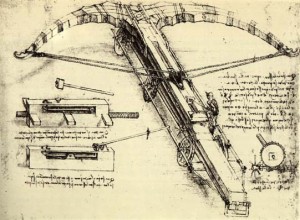
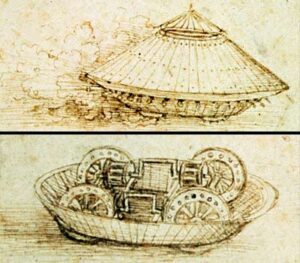
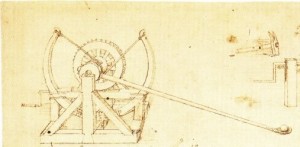
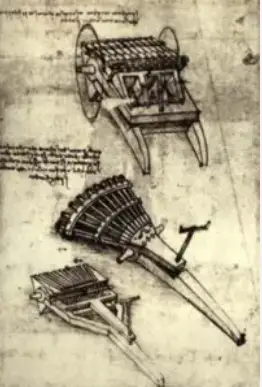

 I’m Leonardo Bianchi, the mind behind Leonardo da Vinci's Inventions. Thanks for visiting.
I’m Leonardo Bianchi, the mind behind Leonardo da Vinci's Inventions. Thanks for visiting. 